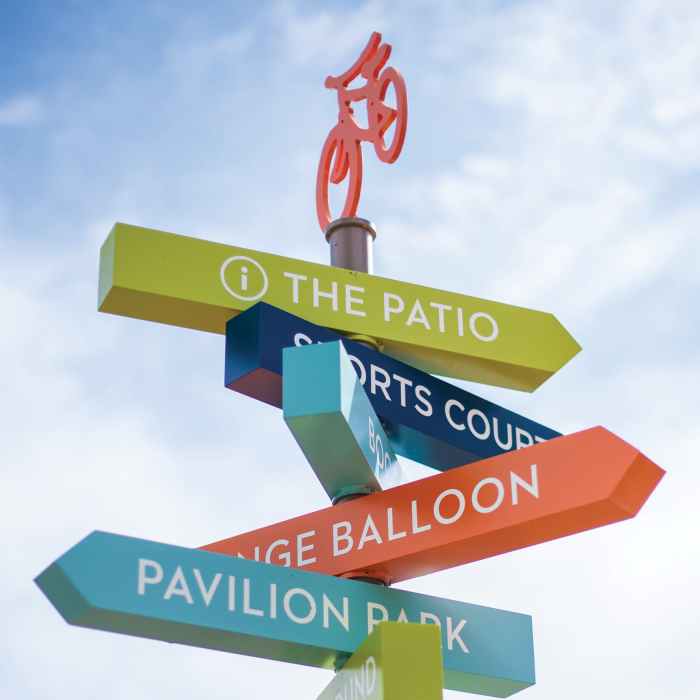Crafting Compelling Signage Designs: A Comprehensive Guide
Embark on a journey into the world of signage design, where creativity meets functionality to leave a lasting impression. From impactful visuals to strategic placement, discover the art of creating signs that speak volumes to your audience.
Delve deeper into the realm of signage design as we explore the key elements, types, process, and trends that shape the way businesses communicate with the world.
Importance of Signage Design
Effective signage design plays a crucial role in the success of businesses by attracting customers, conveying brand messaging, and enhancing overall visibility. A well-designed sign can make a significant impact on customer engagement, brand recognition, and ultimately, sales.
Enhancing Customer Engagement
- Clear and attractive signage can draw customers into a store or business establishment, increasing foot traffic and potential sales.
- Interactive or visually compelling signs can create memorable experiences for customers, leading to better engagement and brand loyalty.
- Signage that provides useful information, such as directions or promotions, can improve the overall customer experience and satisfaction.
Brand Recognition and Visibility
- Consistent branding elements in signage design help reinforce brand identity and make the business more recognizable to customers.
- Strategically placed signs in high-traffic areas or near competitors can increase visibility and attract new customers to the business.
- Unique and creative signage designs can differentiate a business from its competitors and leave a lasting impression on customers.
Elements of Effective Signage Design

Effective signage design encompasses various key elements that work together to create a visually appealing and informative display for the target audience. These elements play a crucial role in capturing attention, conveying information, and establishing brand identity.
Color Schemes
Color schemes are essential in signage design as they can evoke emotions, convey messages, and attract attention. The choice of colors should align with the brand identity and the intended message of the signage. Contrasting colors can help improve readability and visibility, while a cohesive color palette can create a sense of unity and consistency in the design.
Typography
Typography refers to the style, size, and arrangement of text on a signage design. It is important to choose fonts that are easy to read from a distance and match the overall theme of the signage. Bold and clear typography can enhance readability, while creative fonts can add personality to the design.
Proper spacing and alignment of text are also crucial for ensuring clarity and legibility.
Imagery
Incorporating imagery in signage design can help communicate messages effectively and capture the audience's attention. Images should be relevant, high-quality, and aligned with the brand identity. They can enhance the overall visual appeal of the signage and make it more engaging for viewers.
However, it is important not to overcrowd the design with excessive images that may distract from the main message.
Readability and Visibility
Readability and visibility are fundamental aspects of effective signage design. The text should be easily readable from a distance, with proper contrast between the text and background. The size of the text should be appropriate for the viewing distance to ensure that the message is clear and legible.
Additionally, the signage should be strategically placed in high-traffic areas to maximize visibility and reach the target audience effectively.
Types of Signage Design
Indoor, outdoor, wayfinding, and digital signage designs play crucial roles in guiding people, conveying information, and promoting businesses. Each type serves specific purposes and requires unique considerations in terms of design and placement.
Indoor Signage
Indoor signage is designed for use within buildings or enclosed spaces to provide directions, identify specific areas, or display promotional messages. Examples include directional signs in malls, room numbers in hotels, and menu boards in restaurants.
Outdoor Signage
Outdoor signage is meant to attract attention from a distance and withstand various weather conditions. Examples include storefront signs, billboards along highways, and banners at events. Creative outdoor signage designs often incorporate bold colors, large fonts, and eye-catching graphics.
Wayfinding Signage
Wayfinding signage is essential for helping people navigate complex environments such as hospitals, airports, or campuses. These signs typically include maps, directional arrows, and symbols to guide individuals to their destinations efficiently
Digital Signage
Digital signage uses electronic displays to showcase dynamic content such as videos, animations, or real-time information. Commonly found in retail stores, airports, and corporate offices, digital signage allows for easy updates and interactive features. Design considerations for digital signage include resolution, content management, and viewer engagement.
Signage Design Process
Creating an effective signage design involves a series of steps from concept to implementation. It is crucial to follow a structured process to ensure that the signage meets its intended purpose and effectively communicates with the target audience.
Site Surveys and Understanding the Target Audience
Before diving into the design phase, conducting site surveys and understanding the target audience are essential steps. Site surveys help designers assess the physical environment where the signage will be placed, taking into account factors such as visibility, lighting, and surrounding structures.
Understanding the target audience allows designers to tailor the signage to appeal to the specific demographics and preferences of the people who will interact with it.
Prototyping and Testing
Prototyping involves creating a preliminary version of the signage design to evaluate its effectiveness and gather feedback. This step allows designers to make necessary adjustments and refinements before finalizing the design for production. Testing the signage in real-world conditions helps identify any issues with visibility, readability, or overall impact.
By incorporating feedback from prototypes and testing, designers can ensure that the final signage design effectively conveys the intended message and achieves its objectives.
Trends in Signage Design
In the ever-evolving world of design, signage trends play a crucial role in captivating audiences and conveying messages effectively. Let's explore some of the current trends shaping the landscape of signage design.
Minimalism in Signage Design
Minimalism has been a prominent trend in signage design, focusing on simplicity, clean lines, and negative space to deliver a clear and concise message. This approach enhances readability and ensures that the information stands out to the viewers.
Sustainability in Signage Design
With a growing emphasis on environmental consciousness, sustainability has become a key trend in signage design. Utilizing eco-friendly materials, energy-efficient lighting, and recyclable components not only reduces the environmental impact but also resonates with eco-conscious consumers.
Interactive Elements in Signage Design
Integrating interactive elements such as touchscreens, motion sensors, and augmented reality has revolutionized signage design by creating engaging and immersive experiences for the audience. These interactive features not only grab attention but also provide valuable information in an innovative way.
Innovative Use of Technology in Signage Design
The incorporation of cutting-edge technology like digital displays, LED screens, and projection mapping has pushed the boundaries of traditional signage design. These technological advancements enable dynamic content updates, personalized messaging, and eye-catching visuals that capture the audience's interest and leave a lasting impression.
Evolution of Signage Design to Meet Consumer Preferences
Signage design trends continuously evolve to adapt to changing consumer preferences and behaviors. From personalized content to location-based messaging, designers are constantly innovating to create impactful signage that resonates with the target audience and enhances the overall brand experience.
Wrap-Up

As we conclude our exploration of signage design, remember that every sign tells a story. Let your brand's narrative shine through innovative designs that captivate and inspire. Stay ahead of the curve by embracing the evolving trends and techniques in the dynamic world of signage design.
FAQ Resource
How does signage design impact businesses?
Effective signage design can attract customers, improve brand recognition, and enhance overall visibility, ultimately leading to increased foot traffic and sales.
What are the key elements of effective signage design?
Key elements include color schemes, typography, imagery, readability, and visibility, all working together to create a visually appealing and informative sign.
What are the different types of signage designs?
Types range from indoor to outdoor, wayfinding to digital, each serving specific purposes and requiring unique design considerations for different environments.
What is the signage design process?
The process involves steps from concept to implementation, including site surveys, understanding the target audience, prototyping, and testing to refine the design.
What are some current trends in signage design?
Modern trends include minimalism, sustainability, interactive elements, and innovative technology applications that cater to changing consumer preferences.




